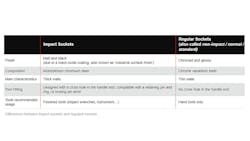Tech Tip: Do you know which socket to use on your impact wrench?
How to differentiate impact sockets from regular sockets?
The main difference is wall thickness, but it is very easy to differentiate between the two by just looking at them: impact sockets are matt while most of the standard sockets are glossy.
Two reasons why you should only use impact sockets for your impact wrench:
- Ensure safety: Contrary to regular sockets, impact sockets are designed to support and absorb the momentary shock of each impact, therefore preventing cracks or breaks, and prolonging the life of the socket. If a regular socket is used on powered tools, the possibility of ruptures is very high. This could result in a serious safety risk for everyone in the same work space as any cracks in the socket can make it explode at any time, causing severe injuries to any operator.
- Achieve optimal efficiency: Impact sockets provide a perfect fit to powered tools, and therefore will avoid unusual deformation or damages to the tool’s square drive.
“Using the right socket for your impact wrench is crucial to ensure safety and efficiency,” said Annabelle Bray, accessories product manager at Chicago Pneumatic.
Information Provided By: Chicago Pneumatic
